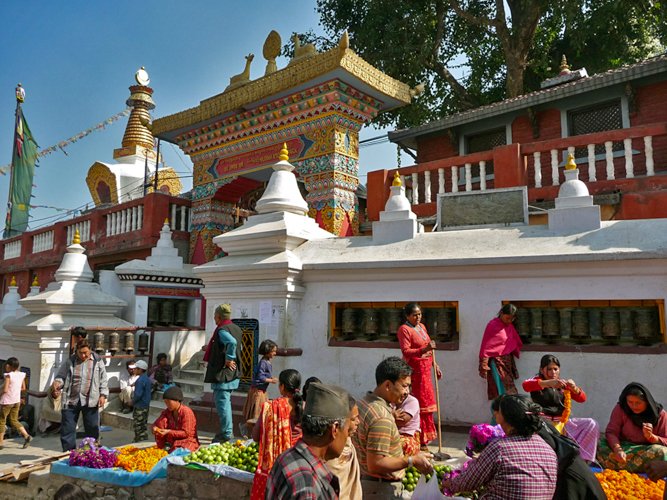In October, 2008, my partner and I spent a week in the Kathmandu Valley. We stayed at the Hyatt overlooking the Boudnath Temple, more correctly spelled Boudhanath stupa, although you’ll find it both ways. I’ll do another post on Boudhanath, this post is to write about our visit to Swayambunath stupa.
Both Boudhnath and Swayambunath have similarities. Devotees circumambulating (big word for walking around) the temples. Both of these temples attract a large Tibetan following. While I was sweating in my short sleeves and light pants, many of these folks were wearing heavy parkas. Ok, not all, but it’s always interesting to see what the weather does to people. Interesting, too, because it was fairly warm in Nepal, where I understand it’s pretty damn cold in Tibet.
I bought a little book after I returned because I wanted to learn more about Swayambunath and I’d taken so many pictures as usual. The book was written by an Englishman named Richard Josephson who lived there for three years and learned about “Swoyambu” from the locals and the pilgrims who continually come to visit in great numbers.
“The origin of the Swoyambhu Valley and its human habitation, with its first town, Manjupattan, is based on the prehistoric legends of the Swoyambhu Maha-chaitya.
Among all the established chaityas and stupas in the Asian continent, the Swoyambhu Maha-chaitya is one of the most ancietn ones, and it is distinguished by its uniquely significant and artistic structures. It is a central symbol of the Buddhist heritage of Nepal.” -Swoyambu “The Origin of the ‘Swoyambhu Mahachaitya’
A Buddhist stupa is (usually) a dome shaped architectural monument protecting some aspect of the Buddha’s personhood, such as ashes, hair or tooth. In Nepal, where Tibetan Buddhism is widely practiced, the stupas are worshipped by circumambulation, as mentioned above.
When we arrived there a monk was chanting while flipping the pages of a small Buddhist canon. I appreciated his graciousness to allow me to take a video of him. I watch this over and over and never get tired of it.
Swoyambunath Stupa
Prayer Flags (Everywhere, they’re so wonderfully colorful and alive)
Shakyamuni Buddha
Mani Wheels (Prayer Wheels)
As Tibetan Buddhists walk around the stupa, they twirl each mani wheel while reciting mantras, such as ‘Om Mani Padme Hum’ stimulating compassion.
